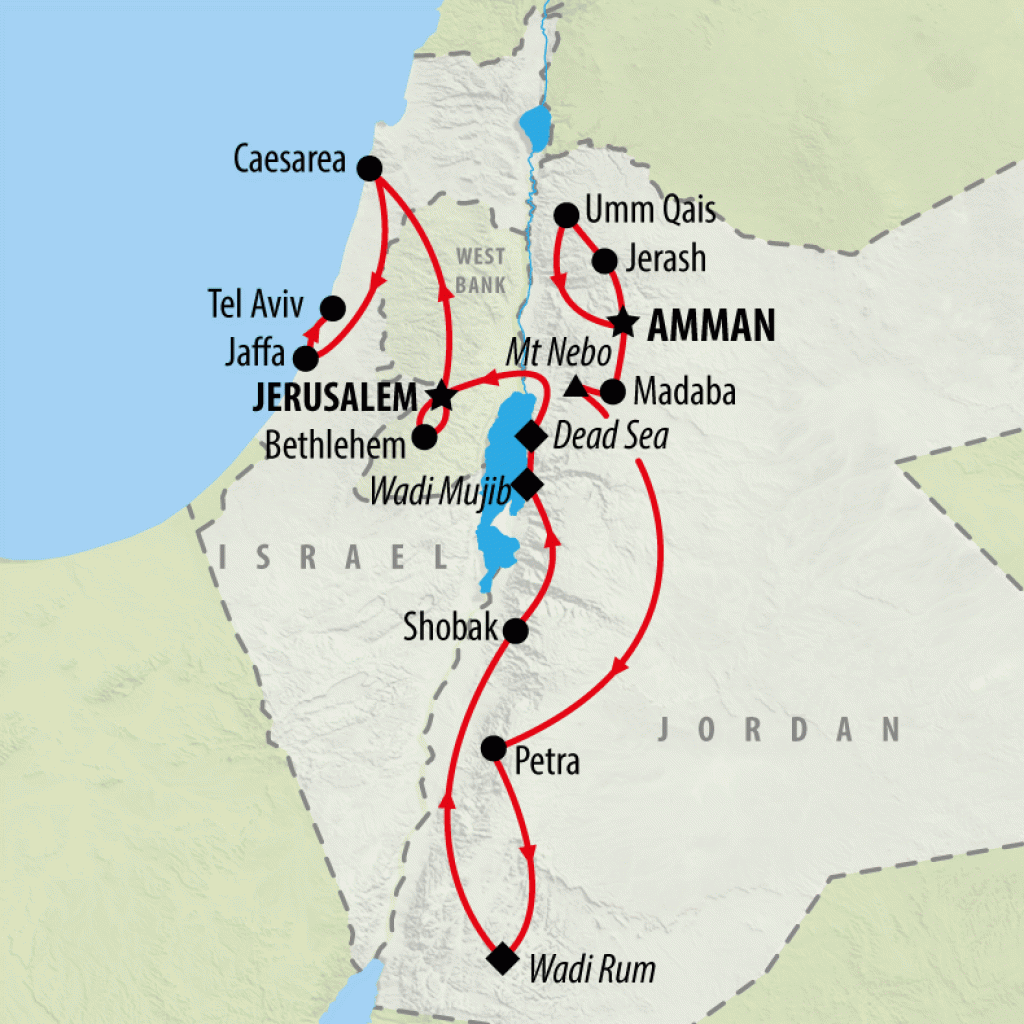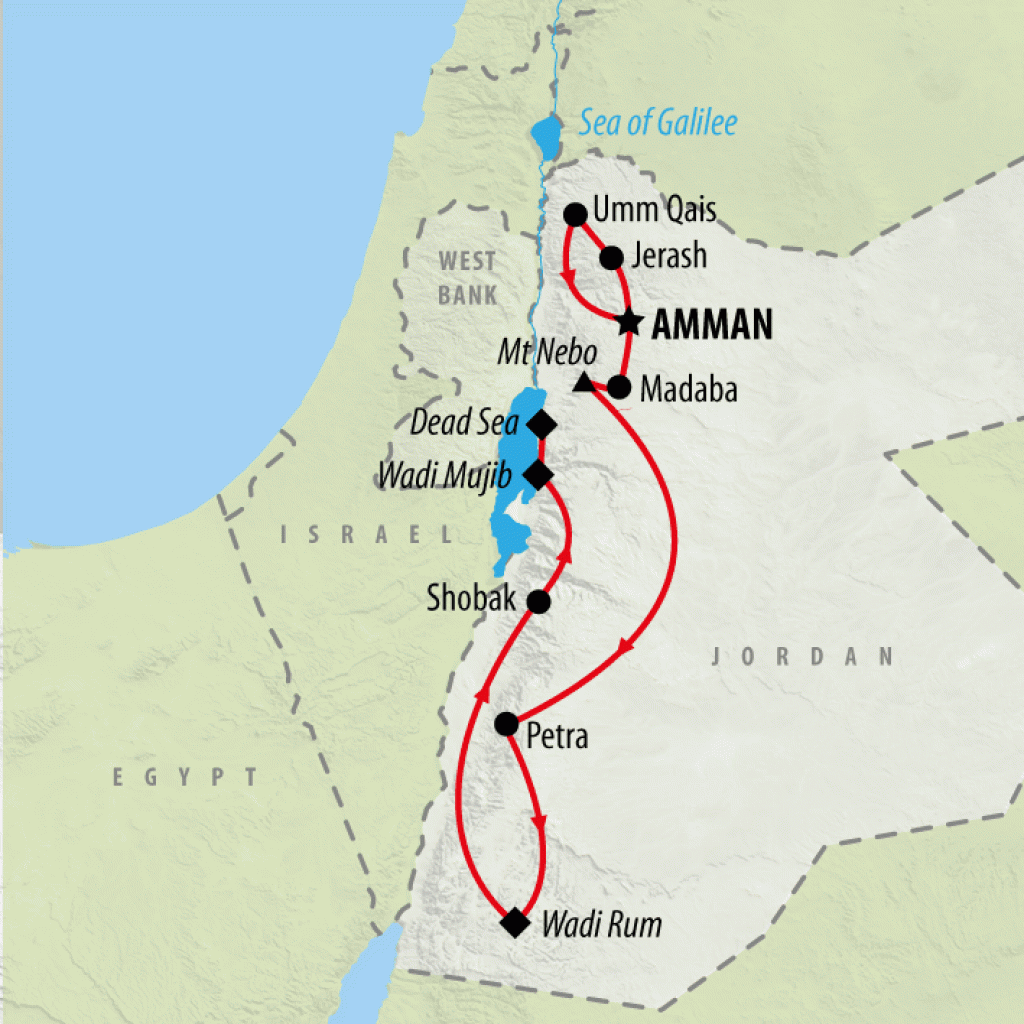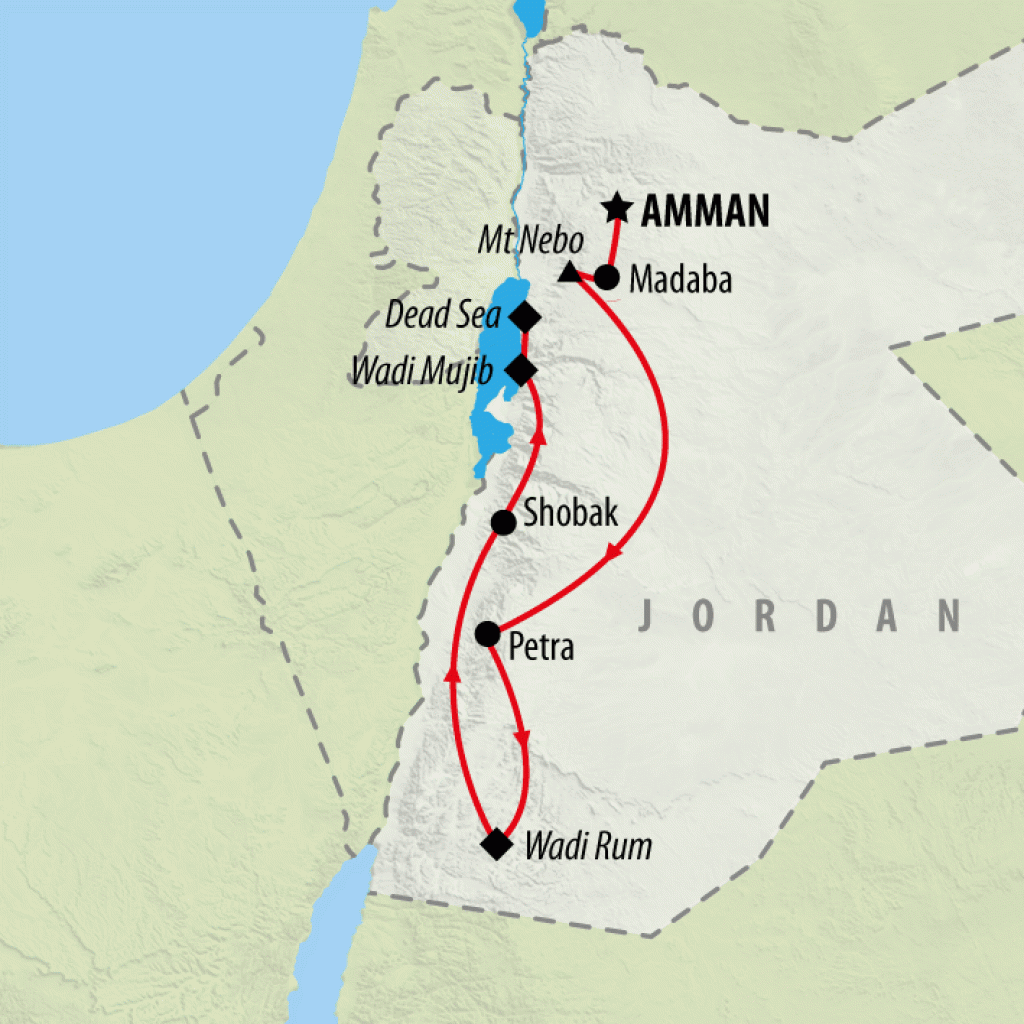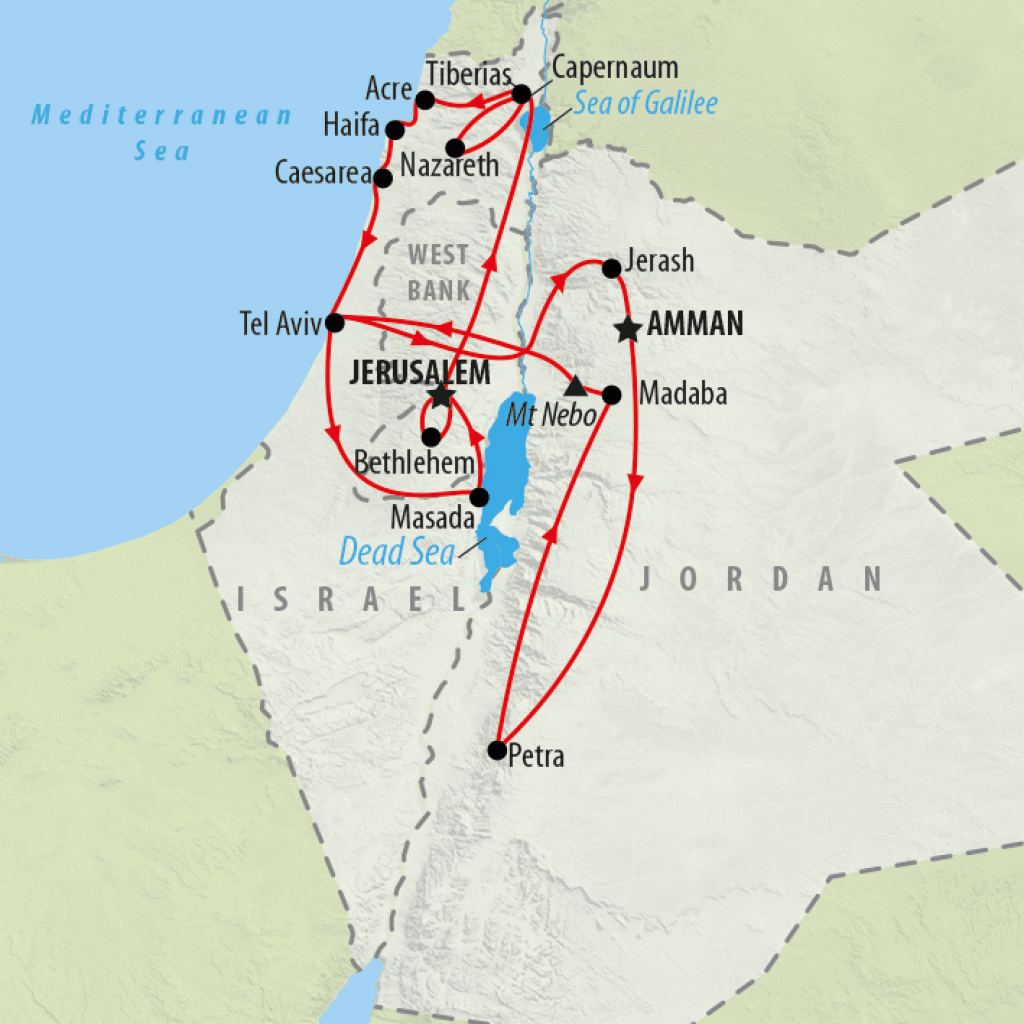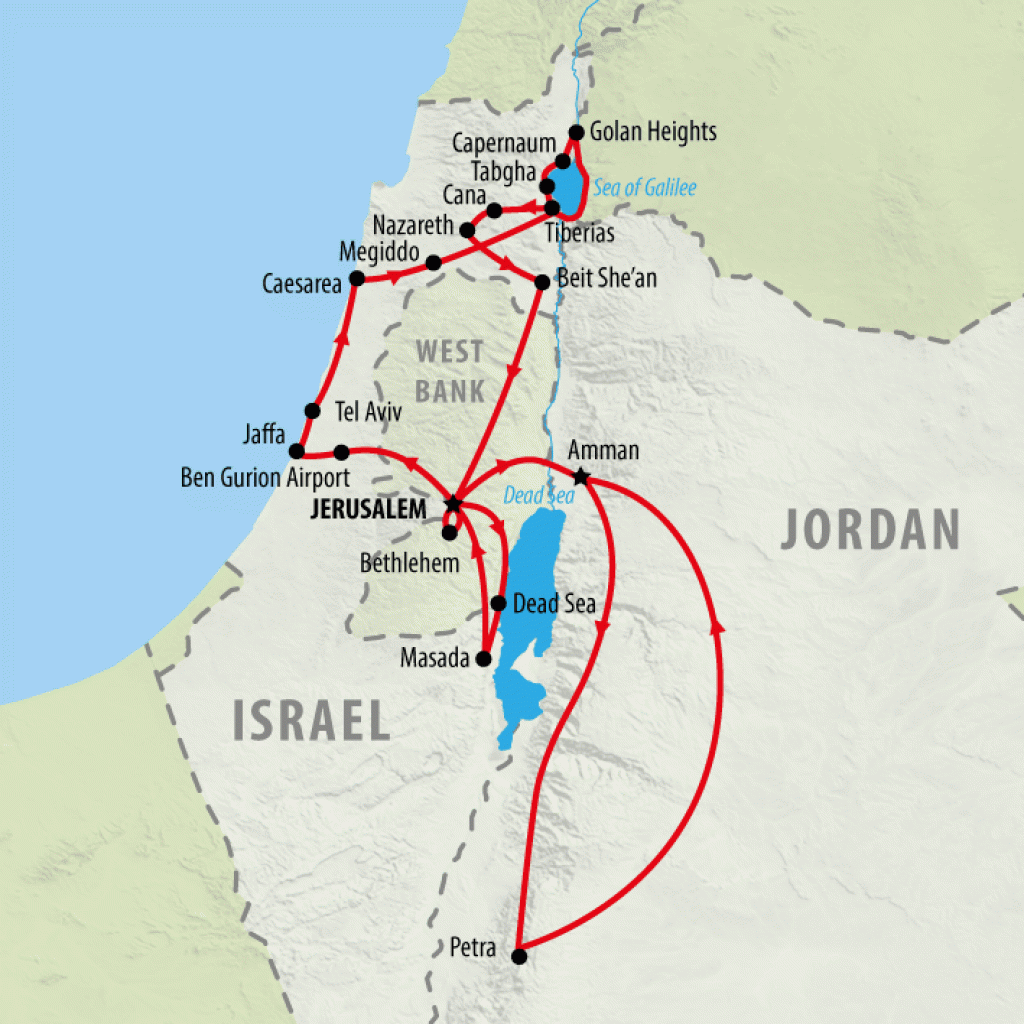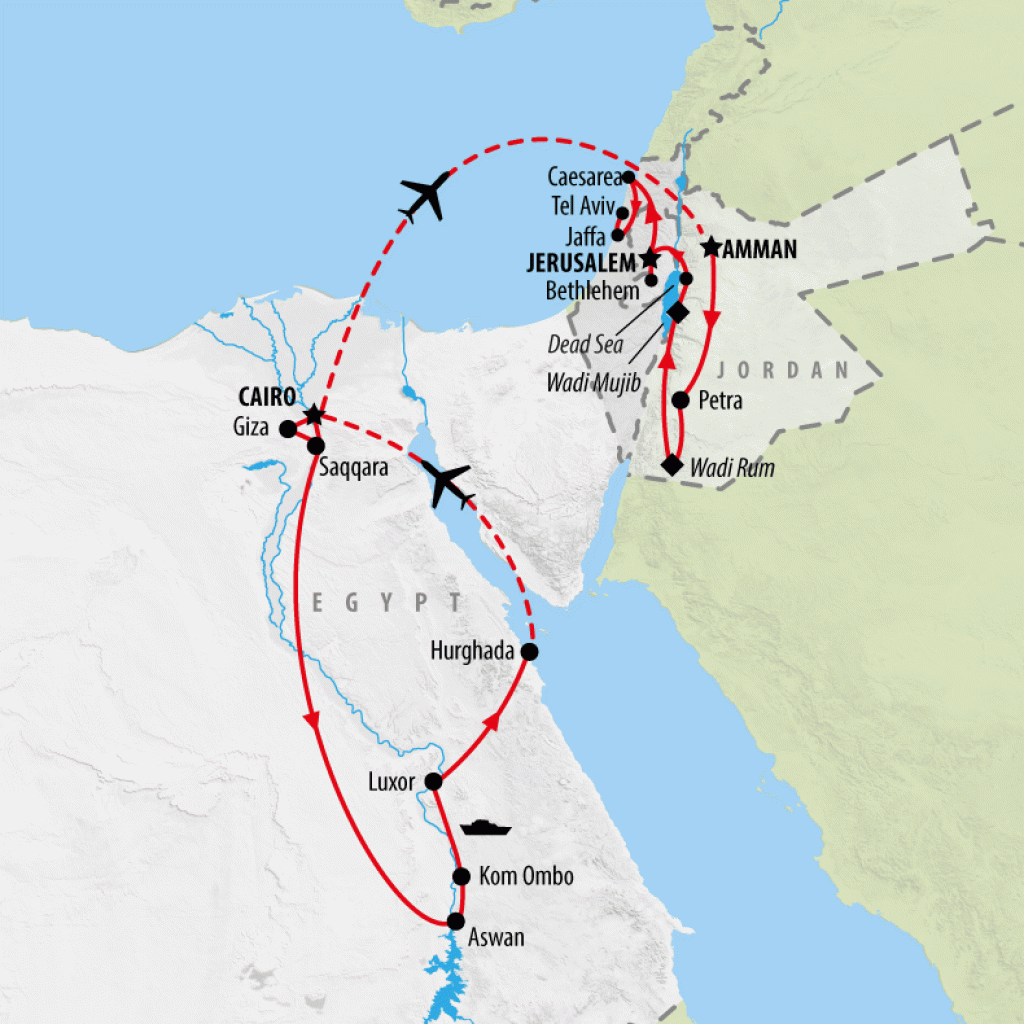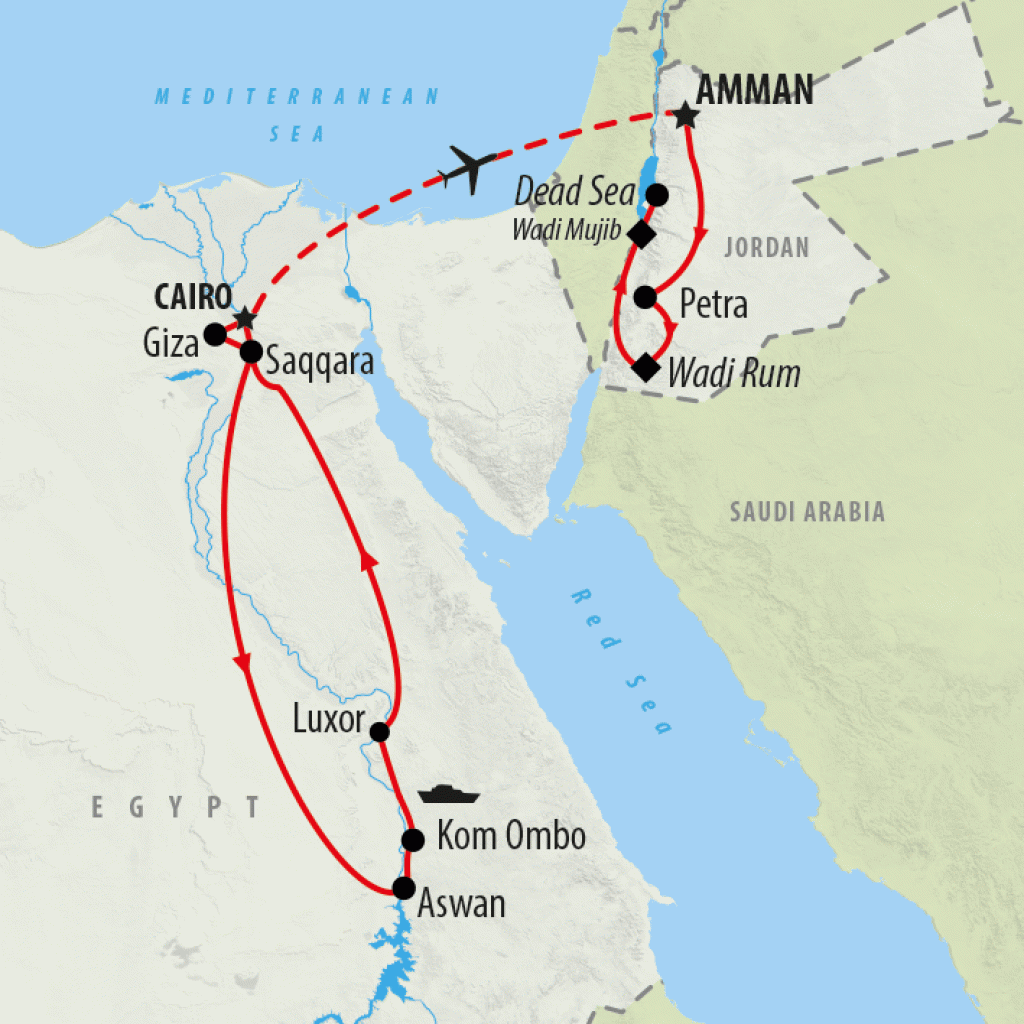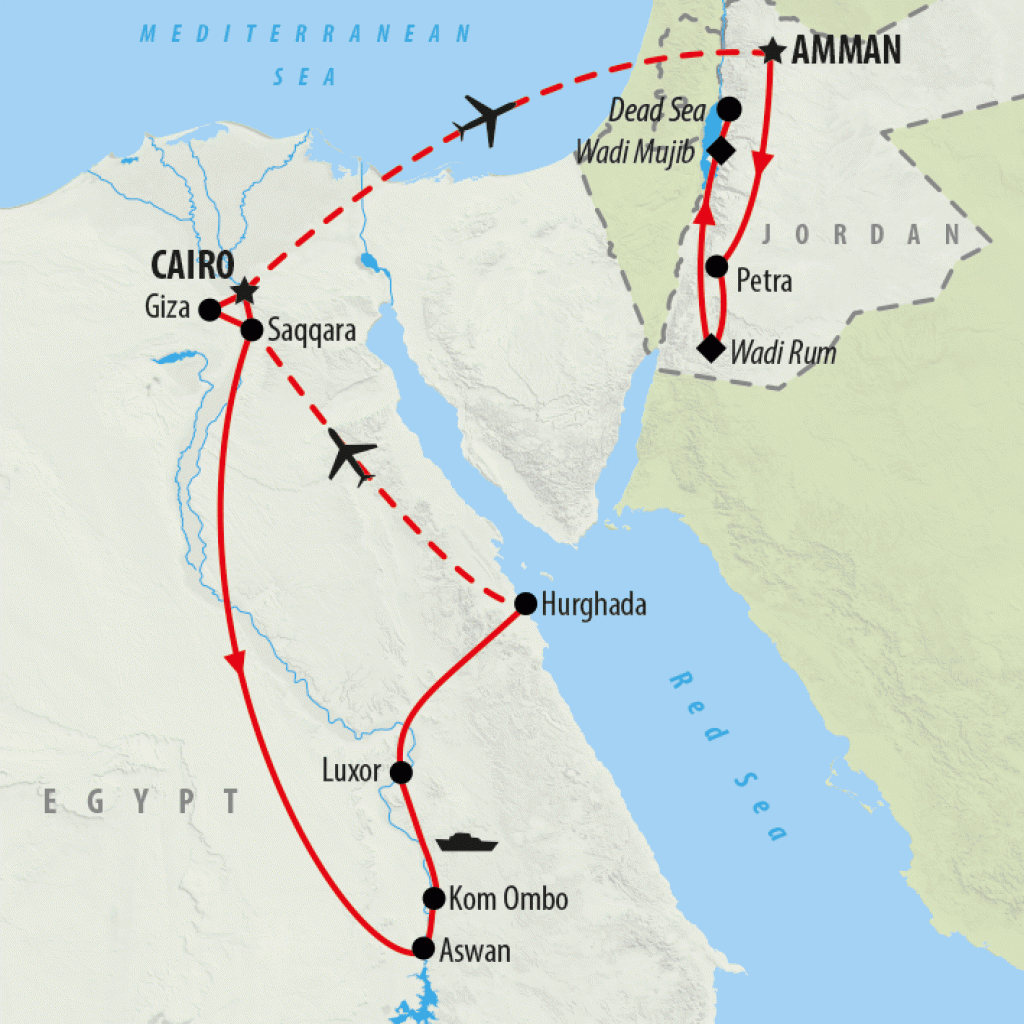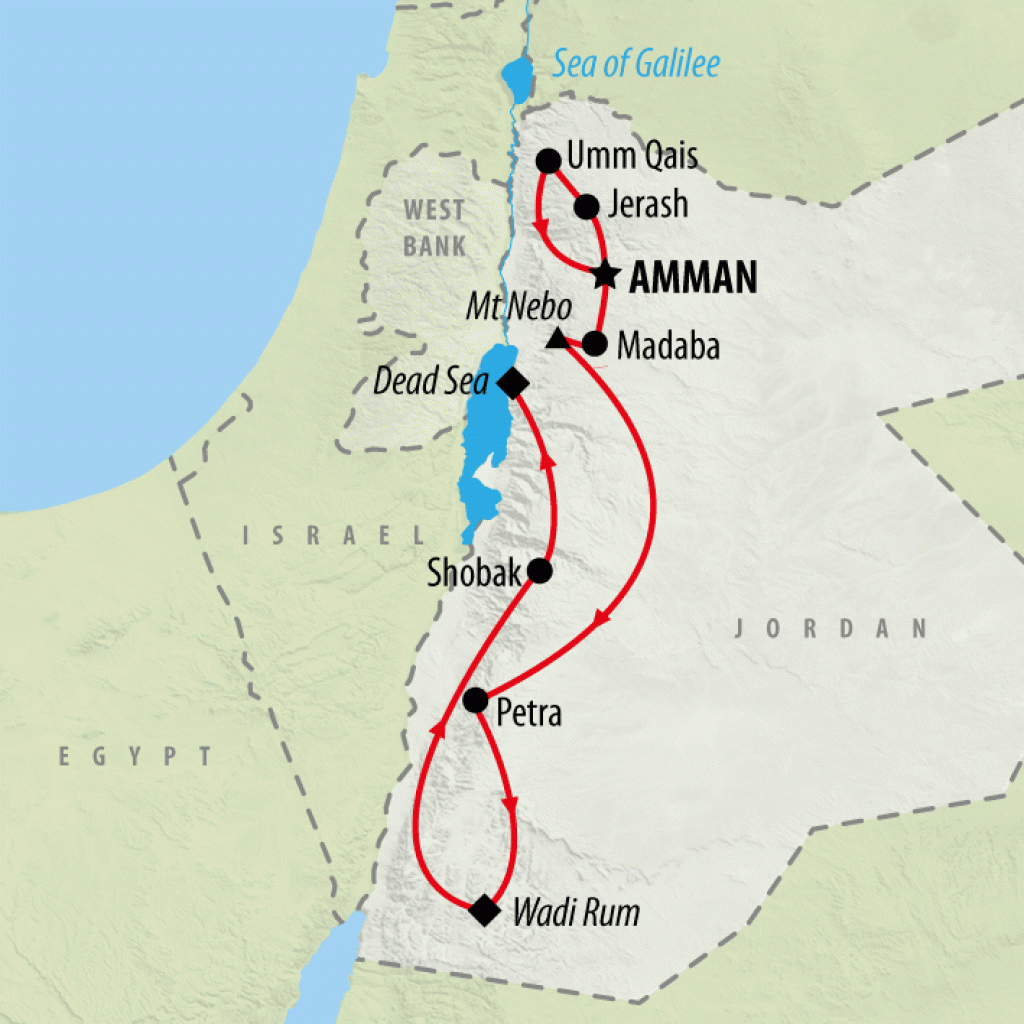The Rose City
Once a thriving caravan city during the time of the Nabataean kingdom, the incredible city of Petra is now considered one of the world's finest archaeological sites. Half-hewn into the red sandstone of the desert, and half-built from its delicately colored rock, Petra is a spectacular example of the blending of ancient cultures from the towering columns of the Hellenistic period to the tombs that follow Eastern architectural traditions. Rightly voted a New World Wonder back in 2007, Petra was unknown to the western world until 1812 and is now Jordan's most visited site.
Spread across an area of 264 square km, there is plenty of scope for hiking opportunities. From the quintessential entrance through the dramatic Siq to more challenging hikes that enter the city from the south, there's no better way to appreciate the sheer scale of Petra than by spending a day or two walking around it.
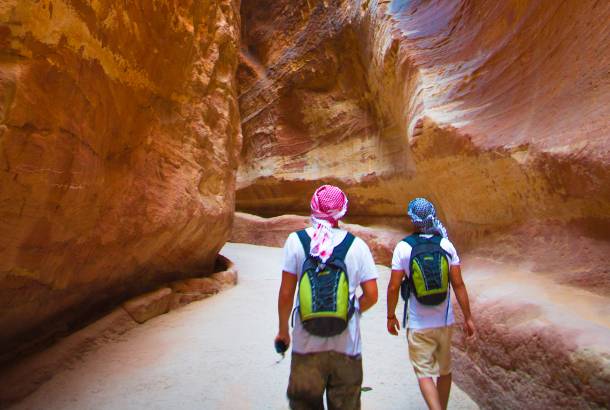
Entry through the Siq
The most popular way to reach the threshold of Petra is via the official entry way, that of the deeply-cut Siq. Formed by a narrow cleft in the sandstone landforms, the Siq provides the most evocative route to Petra, ending at the awe-inspiring facade of the famed Treasury. Winding your way between the two rock faces, with each corner turn holding the anticipation of your first glimpse of the Treasury, really cannot be beaten. For the movie buffs among you, if you've ever watched Indiana Jones and the Last Crusade you'll no doubt want to emulate that view (horses optional).
Siq to the Treasury
The route officially begins at the Petra Visitor's Centre where you can purchase entry tickets and pick up leaflets and a map of the site. On entering the Siq, slow down - it's an experience in itself and one that shouldn't be rushed. At 1.2km in length is also offers a chance to escape the desert heat in the cool shade of the vertical walls. Along the way you can spot original water channels carved into the rock and even a carving of a man and his camel.
Treasury to the Theater
From the Treasury the route follows the Street of Facades where the rock face is lined with tombs, caves and houses worth exploring. The facades range from understated and simple to exquisitely carved and rather grand. Next up is the massive Theater, which was built and then enlarged to eventually accommodate around 8,500 spectators. Dating back to the 1st century AD, the Theater resembles a typical Roman amphitheater with the majority of the structure carved from the mountainside. When opened it affords a fine vantage point from which to observe others making their way to the city center of Petra.
Theater to the Byzantine Church
The route continues to the Colonnaded Street, which marks the heart of the ancient city. Flagstones line the ground and a number of marble-clad sandstone columns still stand either side of the thoroughfare in varying degrees of ruin. There are a number of excavated sites around the Colonnaded Street including the remains of the Royal Palace, the Lower Market and the Nymphaeum - a grand public fountain. Many visitors make a beeline for the Byzantine Church, an ancient structure that suffered extensive damage but has now been partially restored to showcase the remarkably preserved floor mosaics.
Moving on
From here visitors can continue to explore Petra's City Centre and what you add to the day's sightseeing really depends on how much time you have to spend in Petra - if it's just one day then climb up to the Monastery and take in as much as you can. If this is one day of many, leave that for another time.
Hiking Trail Quick Facts:
Sites seen - the Siq, Treasury, Streets of Facades, Theater, Byzantine Church and Museum
Distance covered - 4km each way from the Visitor's Centre
Time estimate - between 4-5hrs round trip
Thinking of visiting Jordan? Download a copy of our Worldwide brochure for inspiration.
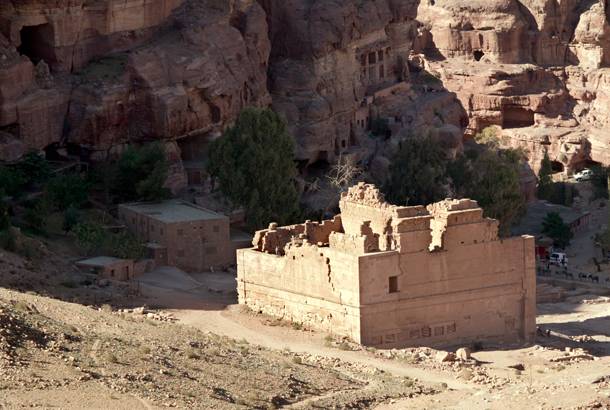
Entry by al Madras
Those with a second day to spare at Petra should seize the opportunity to get off the beaten track and hike the al Madras route, if only for the chance to observe the Treasury from above. It's a chance to appreciate the lunar-like landscape that surrounds Petra, largely all to yourself as few other visitors opting for this journey. The trail is unmarked you'll need to hire a local guide.
From the Main Gate to the High Place of Sacrifice
This is one of the best Petra hiking trails. It starts from the main gate near the Visitor's Centre but veers left of the Siq to climb over the rocky terrain along its southern cliff. Those who suffer from vertigo may find the steep escarpments challenging with several scrambles required. But it's worth the hour effort when you arrive at the vantage point that gives you an undisturbed view of the Treasury from up high. The 'viewing platform' is big enough to lie out across for the ultimate Petra selfie.Continuing along the rugged mountainside, the trail retraces its steps for a bit before heading in a northwest direction to the High Place of Sacrifice, Petra's best-preserved sacrificial site. The entrance is marked by two 6m-tall obelisks made all the more impressive by the fact that were carved from the rock rather than placed on top. The main altar area is marked by a levelled platform, three steps and a large stone block that would have once housed religious statues during rituals and processions.
Walking down from the High Place of Sacrifice via Wadi Farasa
The route down into Petra's center follows the western cliff of the Attuf ridge via Wadi Farasa (Butterfly Valley) where you can see a number of monuments and tombs. It's also a particularly scenic area with amazing rock formations decorated with rich mineral colors and wild flowers. The descent is steep in places and takes you pass the Lion Monument - a fountain carved into the shape of a lion, the Roman Soldier's Tomb, which features three carved statues, and the Garden Triclinium - a simple cave used for annual feasts and overlooked by a large tree. The trail continues pass the Az-Zantur residential mansion (currently undergoing excavations) and nearby Nabataean and Roman houses to the Pharaoh's Column, which serves as a useful landmark for onward trails.
From the Pharaoh's Column to the Royal Tombs
It's not far from Petra's City Centre with a path leading from the column to the back of the market area. It's then a stone's throw to the Great Temple, the largest freestanding building uncovered in Petra. Excavations began in 1993 and continue to this day, revealing a small theatre that may have served as an assembly hall, as well as hexagonal floor stones and dozens of columns. Archaeologists even uncovered a carving of an elephant - a first in Petra.
Moving on
Once again, if this is your last day in Petra then it's sensible to continue further on to the Monastery but if you've got a spare day to follow, head back east to the Royal Tombs where you'll find Petra's most impressive burial sites. It'll be the perfect time to visit them too, with the late afternoon sun bathing the sandstone in a warm, soft light. Modern steps lead up to where the tombs sit high above the Wadi Musa. Star tombs among the offering include the Urn Tomb - notable for its massive urn, the attractive Silk Tomb with veins of delicate colors in the rock facade, and the three-story Palace Tomb.
Hiking Trail Quick Facts:
Sites seen - Obelisks, High Place of Sacrifice, Wadi Farasa, Great Temple and Royal Tombs
Distance covered - 10km
Time estimate - between 7-8hrs
Note: Although you don't have to be a world-class hiker or rock-climber to do this trail, a moderate level of fitness is required.
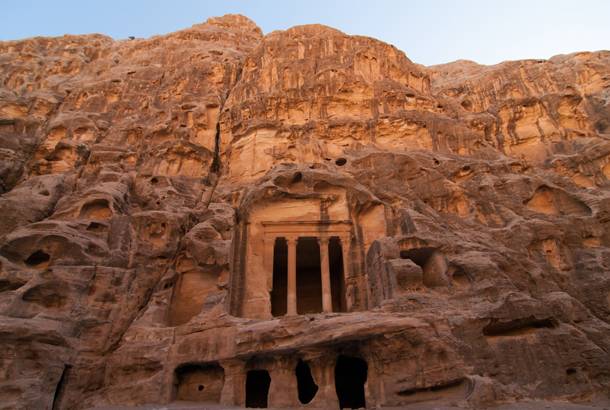
Entry via Little Petra
If you've not had enough of Petra and the surrounding area, another great hiking option is the route that takes you from Siq al-Barid, frequently referred to as Little Petra for the similarities between the two - like its bigger sister, here a small canyon leads to a number of familiar-looking facades and temple ruins. During the time of the Nabataeans the site served as a customs point on the northern edge of the city of Petra.
From Little Petra to Al-Beidha Neolithic site
The day starts with a road transfer to Little Petra where some time is spent exploring the archaeological ruins and the Siq. From here it's roughly a 20 minute walk to the Al-Beidha Neolithic site, which contains a collection of remains that are considered to be some of the oldest in all of the Middle East. Dating back some 9,000 years, the ruins found here include hearths, storage houses and large stone implements that suggest settlers here were hunter-gatherers and relied on agriculture.
From Al-Beidha to the Monastery
Here's where the hiking begins in earnest as departing the Neolithic site you'll be confronted with a seemingly unending horizon of barren desert and pockmarked rock formations. It's a cross-country hike across Wadi Merwan and one that will certainly impress Petra's surrounding landscape on your memory. The trail leads to the ad-Deir, commonly known as the Monastery that also serves as Petra's 'backdoor'. It's the largest carved facade and easily rivals the Treasury for awesomeness. Built in the 3rd century, the Monastery served as a tomb and may have also been used as church in Byzantine times.
Moving on
It's easy to while away the time at the Monastery with a cave opposite transformed into a Bedouin-styled cafe with a drinks stall and cushions and rugs spread out across low seats. If you set out early for the hike, in all likelihood you'll have the place largely to yourself. When you're ready you can continue down the 800 rock-cut steps that lead to Petra's City Centre and feel somewhat smug when you pass the crowds making the arduous climb up those same steps on their way to the Monastery.
Hiking Trail Quick Facts:
Sites seen - Little Petra (Siq al Barid), Al-Beidha Neolithic site, Wadi Merwan, the Monastery (ad-Deir)
Distance covered - 10km
Time estimate - around 6hrs
Note: This trail also requires a moderate level of fitness as a fair distance is covered and some sections require scrambling.
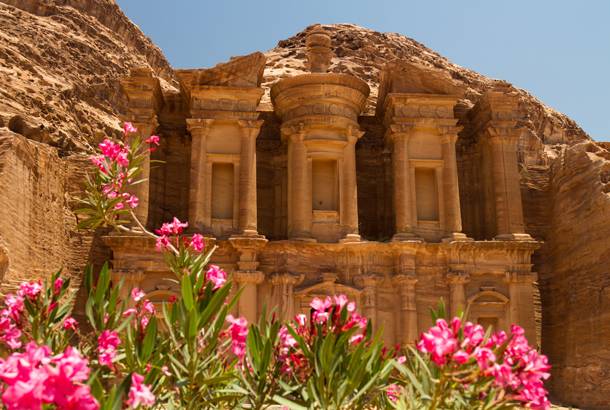
Best time to hike around Petra
The best time to hike around Petra is in the seasons of spring (March to May) and autumn (September to November). At these times of year temperatures range from mild to tolerable with little rain. Spring has the added bonus of blooming wild flowers, which make parts of Petra even more beautiful than usual.
Temperatures during the summer (June to August) hit the mid 30s centigrade/low 90s Fahrenheit and with the mercury this high, hiking becomes much harder. During the wetter winter months of December to February sections of these hiking trails are mercy to flash floods and you'll likely be wading through pools of cold water. This is considered the worst time for hiking.
Visit our best time to visit page for more information on the weather as well as festivals and events in Jordan to help you plan your larger trip.
Top tips for making the most of hiking in Petra
Start early - in the summer months the midday heat can be unbearable so setting off for your hike as early as possible will mean you're walking in the cooler morning temperatures. If you're only doing the Siq entry hike it also means you'll arrive at the Treasury before the crowds get busy.
Wear good boots - if you're opting for the al-Madras or Little Petra hiking routes, you'll need a comfortable and sturdy pair of walking boots as you'll be scrambling over rocks and loose stones. Even if you're only entering via the Siq it's still sensible to choose trainers or boots.
Prepare for the heat - take a wide-brimmed hat, plenty of water and sunscreen as that desert sun is fierce and parts of the hiking routes are totally exposed.
Pack a picnic - enjoy alfresco dining in Petra and take a packed lunch with you as there will be plenty of scenic spots to rest up for a while and have a bite to eat during your hike.
Check out more of our top travel tips for visiting Jordan.
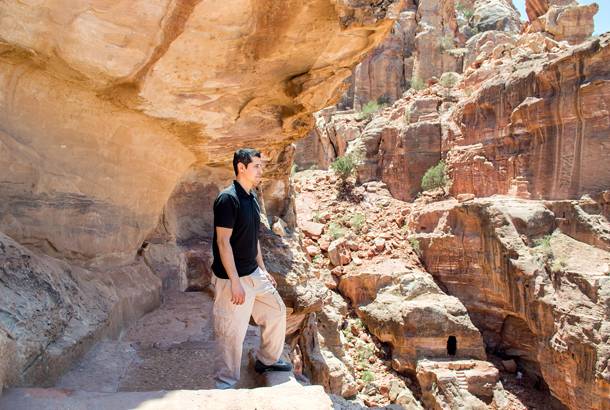
Plan your hike to Petra
A visit to Petra is included on all of our Jordan group tours with entry via the Siq and an included visit to the ad-Deir Monastery. If you would prefer to spend more time in Petra, perhaps trying all three hiking trails detailed here, then our tailor-made holiday team are on hand to create your ideal itinerary.




















